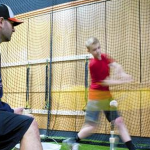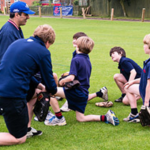Developing an Athlete Centered Coaching Style
There are several different coaching philosophies that have produced positive on the field results. Fans of professional and college sports teams often think that a coach who is constantly yelling is constantly coaching. Listen to a local sports talk radio station of a struggling team and you will hear several callers declare that the current coach should be fired and someone needs to “light a fire” under the players. What does that phrase really mean? Several coaches have had successful careers by “lighting fires” under their players and getting them to do what is expected of them by being forceful, threatening and frightening. The all time wins leader in NCAA basketball history, Bobby Knight, made a living out of “lighting fires” under his players. His methods were considered very old school, and many fans romanticize about coaches like Bobby Knight and feel that his methods are the best way to get the most out of kids and professional athletes alike.
I would like to respectfully disagree with those people who feel that this method of coaching is the most effective. Again, this “coach as a tyrant model” can get results on the field, but what are we teaching these athletes about decision making, about having confidence in themselves, and about being leaders? One of the major objectives of youth sports should be to develop character in our players. If we simply give orders, and make demands on them, all they will learn how to do is to take orders and follow directions. These abilities are valuable and will serve the athlete well later in life, but later in life, their future employers are looking for someone who can be a leader, think critically and make decisions. These are the qualities I believe we should be bringing out and developing in our athletes.
Get Access To Our Complementary Online Coaching Library
It is my belief that the best method to both get results on the field and in an athlete’s life is by adopting an athlete centered coaching style. Without doubt the toughest thing about adopting an athlete centered coaching philosophy is the coach’s feeling of a loss of control. As a coach we believe we should be the leader of the team. Even though this thought process is correct, think about how a well run business is organized. The CEO (coach) has a board of trustees and managers below them (assistant coaches and/or captains) who lead innovative, creative, and independent employees (remainder of your players). If a multimillion dollar corporation can succeed by giving power to people who work for the CEO, surely a youth, high school or college sports team can run in a similar fashion.
One thing that will calm the coach’s fear about giving up some of the control of his team is to understand how much of the control should be given to his players and assistant coaches. The first thing a head coach should do is to make an honest assessment of how much his assistants and players are capable of doing on their own. Assistant coaches who are very knowledgeable can be given a lot of control. If your assistants are new, or not very knowledgeable, it is the head coach’s job to help them grow as coaches, and to give them one or two areas of the game learn and be in control of at practices and during games. Start them small and as their confidence and knowledge grows, so can their responsibilities.
The same can be said for your players. If you have a veteran group of players, you can give them a lot of control of practices, and have some input on in-game decisions. However, if you have a young, inexperienced team, you (and hopefully your assistants) are going to have to do a lot of the instruction yourself. Remember the ultimate goal should be to give control to your players as the season goes on. Look for ways you can have athletes run drills. Continue to give them more and more control as they get more and more comfortable. If you have a few players who stand out as leaders, look for ways to give those players more responsibility.
The transition from a coach centered team to an athlete centered team is a difficult one for a coach to make, and it must be made at the right pace. If it is made too quickly, you will see your team’s on field performance slip due to a lack of direction and instruction, if you make the move too slowly, you will be stifling your assistant coaches and players development as problem solvers and leaders.
The next few posts will describe ways to transition from a coach centered team to an athlete centered team.
To learn more about being an athlete centered coach, check out or Silver Certification at www.cornerstonecoachingacademy.com/silver-certification.
More from my site
 CCA Podcast 176 – How we used Blast sensors with our team
CCA Podcast 176 – How we used Blast sensors with our team Mini – Overload and Underload Bats
Mini – Overload and Underload Bats CCA Podcast 004: Selecting a Baseball Private Instructor
CCA Podcast 004: Selecting a Baseball Private Instructor CCA Podcast 087 – 5 ways to make practices more game like
CCA Podcast 087 – 5 ways to make practices more game like CCA Podcast 171 – Running youth practices
CCA Podcast 171 – Running youth practices CCA Podcast 123 – 10 tips for a more efficient batting practice
CCA Podcast 123 – 10 tips for a more efficient batting practice
 Posted by Kyle Nelson
Posted by Kyle Nelson- Posted in Uncategorized
 Oct, 16, 2013
Oct, 16, 2013 6 Comments.
6 Comments.
Elite members login here
Check out what’s New/Hot!
Recognizing, Diagnosing, and Fixing Common Hitting Flaws eCourse The 3 metrics we tested on Blast motion sensors this year Sneak Peek Inside an Elite Q and A The batting practice continuum Elite Member’s area table of contents 50+ “Chaos” hitting drills
5 sample Chaos hitting drills FREE
Mental Skills and Culture Building The hitting pyramid Welcome Elite Member, Trey! Ideas for a pitcher first practice 12 week bat speed improvement plan Make plans this offseason to have your team playing their best baseball at the end of the year” Top 5 hitting drills to translate practice skill to game performanceHow we used Blast Motion sensors with a team in 2019
What to do if your hitters are overmatched Welcome Elite Member, Tommy! Setting your baserunners up for success Welcome Elite Member, Mike! A consulting call with Elite Member Matt FREE Web Clinic: Developing Athletic, Consistent, Extraordinary Infielders
 Coach Kyle Nelson
Coach Kyle Nelson
Kyle,
Good point about comparing an athletic team to the organization of a company. Keeping this in mind could be part of your coaching philosophy that every coach should develop.
To take it one step further, teenage athletes are VERY different these days. They are more interested in their iPhone, Twitter, Instagram…a world where communication and access to information is so immediate. As coaches we have to find a way to get players to take ownership of learning the game, not just forcing it down their throats by yelling and screaming. If you can figure that out, you are going to build a better team and better, more successful people.
Mike-
Thanks for the comment, and could not agree more. The world is changing. I’m sure every generation has dealt with similar problems as they tried to coach the one (or two) below them. It’s always a matter of trying to reach kids and find out what makes them tick and incorporating that into your coaching.
Kyle
I think it’s important to empower your athletes because when push comes to shove they have to act and make decisions on the field. They can’t wait for you to tell them what to do. Giving them that ability in practice might make it easier to do so during a game.
@Jodi-
I wish I could take the field with my players and guide them through everything they needed to do… but they don’t let me play anymore. So the goal needs to be to teach them to be decision makers so when they take the field, they perform without thinking.
This decision making ability can only help them later in their careers.
I believe in what has been said to a point. That point would be age group. How young can you take this philosophy. I realize the assistant coaches can and will take on more of the load, regardless of the age group. What is the magic number for the players.
I think it looks different at different ages. It also looks different with different teams. At young ages, try to turn over any little thing you can to the kids. Have them set up drills, have them run warm-ups. Any little thing you can turn over to them will benefit them in the long run.
Here is a really simple scenario that happens a lot in youth baseball where you can allow players to make decisions instead of telling them what to do:
You have 13 players on your team. Inevitably, the “odd man out” comes up to you and asks what he should do. There are clearly two options for them… join a group and play three-way, or sit on the side. Instead of telling him what to do, just ask him what he thinks he should do and let him make the right decision. It seems small, and it is, but with young kids, any control you can give them puts them on the path to be able to be independent decision makers.
When introduction age appropriate tactics through tactical games to young kids, you might find that they pick up quicker that way. You are essentially working with a blank slate and they haven’t had much time to learn bad habits yet. Watch a group of 6 or 7 year olds play “running bases.” You will observe many of the principles you want to teach players in rundowns.
I have also found that not all teams are created equal. Some teams can handle more control, and some teams cannot. I don’t give up on athlete centered coaching when I have a team that is immature or doesn’t have any leaders. I just know I need to find different ways to give them control and ownership.